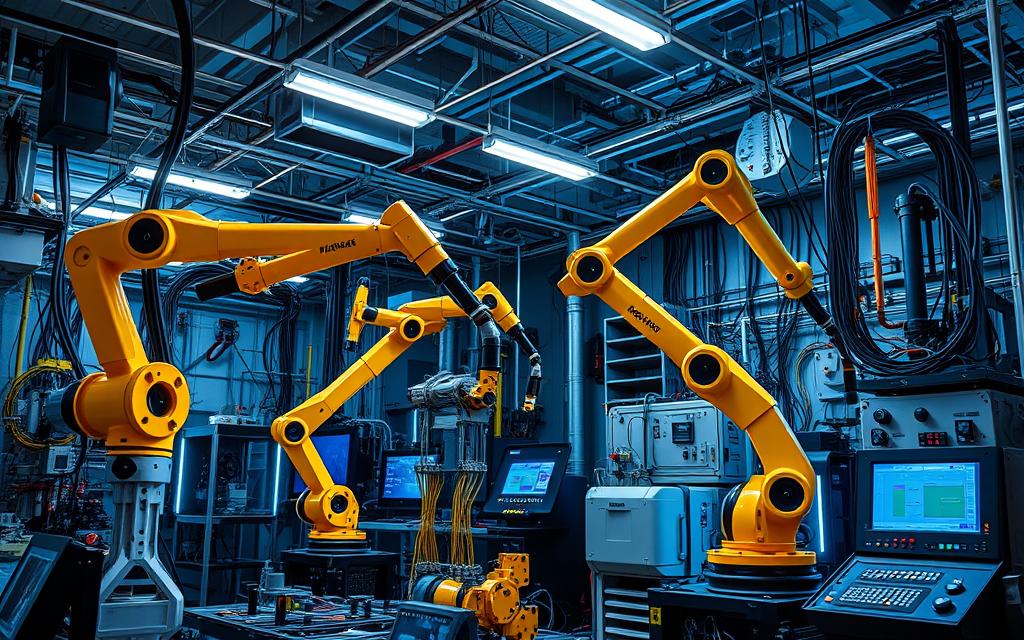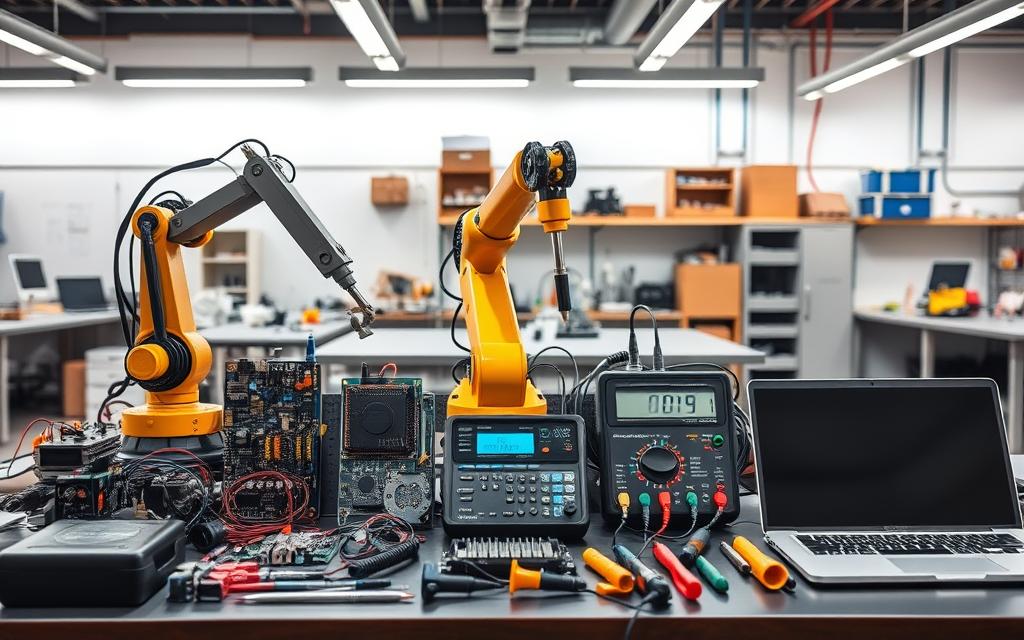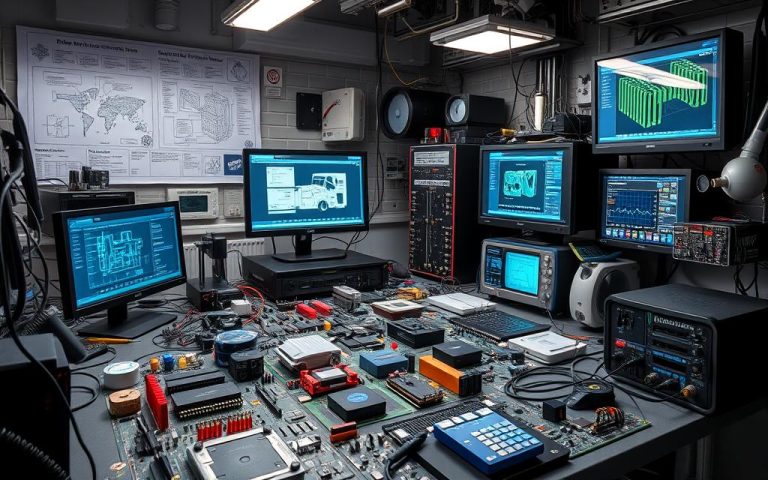What Is Electromechanical Engineering Technology? Explained
Electromechanical engineering technology blends electrical and mechanical systems. It creates new solutions, pushing electromechanical systems forward. This field is key in making engineering innovations that change industries and our daily lives.
At its core, electromechanical engineering technology combines electrical and mechanical systems. It designs, develops, and implements new solutions. It’s a field that’s driving technological progress, full of opportunities for those who love solving problems and innovating.
We’ll dive into electromechanical engineering technology’s basics, its history, and its uses today. We’ll see why it’s so important for the future of engineering and electromechanical systems.
Understanding Electromechanical Engineering Technology
Electromechanical engineering technology has seen big changes thanks to technological advancements. It combines electrical and mechanical systems to make new solutions. This field has a long history, shaped by many mechanical engineering pioneers.
To really understand electromechanical engineering technology, we need to look at its core principles and fundamentals. These basics are what the field is built on. They have changed over time, thanks to new technologies and ideas.
Core Principles and Fundamentals
The main ideas of electromechanical engineering technology are about how electrical and mechanical systems work together. It studies things like motors and generators. Knowing these basics is key for making today’s modern tech, which is all about technological advancements in mechanical engineering.
Historical Development
The history of electromechanical engineering technology is full of important moments. It started with early experiments with electricity and grew into complex systems. Each step was made possible by many people and the technological advancements of their time.
Modern Applications
Today, electromechanical engineering technology is used in many ways. It’s in robotics, automation, energy systems, and transport. The field keeps growing, thanks to technological advancements and the need for new ideas in mechanical engineering. As tech gets better, so will the chances for new uses and discoveries in electromechanical engineering technology.
The Fusion of Electrical and Mechanical Systems
The mix of electrical engineering and mechanical systems has opened a new door to innovation. This blend allows for the making of complex systems. These systems can do many things, like automating in manufacturing and creating advanced robotics.
Some main benefits of this mix are:
- Increased efficiency and productivity
- Improved accuracy and precision
- Enhanced reliability and safety
As electrical engineering keeps growing, we’ll see more exciting changes in electromechanical engineering technology. The need for automation and smart systems will make the mix of electrical and mechanical systems key in shaping tech’s future.

In summary, the mix of electrical and mechanical systems is a strong combo. It has the power to change many industries and our lives. By using electrical engineering and automation, we can make new solutions. These solutions will change how we live and work.
| Field | Application | Benefits |
|---|---|---|
| Manufacturing | Automation | Increased efficiency and productivity |
| Robotics | Sophisticated robotics | Improved accuracy and precision |
| Energy Systems | Smart grids | Enhanced reliability and safety |
Essential Skills and Knowledge Areas
To do well in electromechanical engineering technology, you need technical skills, software know-how, and problem-solving smarts. This field is always changing, thanks to new control systems and robotics. So, it’s important to keep up with the latest tech and methods.
Designing, making, and using control systems is a big part of this job. You need to know about programming, circuit analysis, and microcontrollers. Also, being good with software like CAD design and simulation tools is key for testing and designing systems.
Electromechanical engineering technologists must solve complex problems creatively. They use math and science to improve and test systems. Some important skills and knowledge include:
- Technical skills in circuit analysis and microcontrollers
- Being good with CAD design and simulation tools
- Problem-solving skills to tackle complex issues
- Understanding robotics and control systems for design and use
With these skills and knowledge, you can thrive in electromechanical engineering technology. You’ll help create new solutions that mix electrical and mechanical systems.
| Skill/Knowledge Area | Importance | Description |
|---|---|---|
| Technical Competencies | High | Knowledge of circuit analysis, microcontrollers, and other technical areas |
| Software Proficiency | Medium | Proficiency in CAD design and simulation tools |
| Problem-Solving Abilities | High | Ability to analyze complex problems and develop creative solutions |
| Robotics and Control Systems | High | Knowledge of design, development, and implementation of robotics and control systems |
Educational Pathways and Qualifications
Starting a career in electromechanical engineering technology needs a solid base in engineering education. You can get this through different educational paths. These include bachelor’s and master’s degree programs in relevant subjects. A bachelor’s degree in electromechanical engineering technology or a similar field is usually needed for entry-level jobs.
If you want to move up, a master’s degree in technological education or a related field can help. It gives you special knowledge and skills. Professional certifications also boost your career and show your expertise in certain areas.
Important areas in engineering education for electromechanical engineering technology include:
- Electrical and mechanical systems design
- Control systems and automation
- Robotics and mechatronics
By choosing a career in electromechanical engineering technology through technological education, you gain the skills and knowledge to thrive in this dynamic field.
Industry Applications and Specialisations
Electromechanical engineering technology is used in many industries. It focuses on automation and energy systems. This technology combines electrical and mechanical systems. It makes complex devices and systems that can do many tasks.
In the manufacturing sector, automation is key to boosting efficiency and productivity. Electromechanical systems control and monitor production lines. This ensures products are made fast and to a high standard.
Manufacturing and Automation
- Control systems for production lines
- Robotic assembly and welding
- Quality control and inspection systems
Robotics and Control Systems
Robotics and control systems are vital in modern manufacturing. They help make high-quality products at a lower cost. Energy systems are also important. They provide the power needed to run these systems.

Energy Systems Integration
Integrating energy systems is essential for efficient electromechanical systems. It includes using renewable energy like solar and wind power. This reduces reliance on fossil fuels and cuts environmental impact.
| Industry | Application | Benefits |
|---|---|---|
| Manufacturing | Automation and control systems | Increased efficiency and productivity |
| Energy | Renewable energy systems | Reduced environmental impact and energy costs |
Tools and Technologies in the Field
Electromechanical engineering technology uses engineering tools a lot. These tools help design, develop, and test systems. Software like computer-aided design (CAD) and simulation tools are key. They let experts create and check complex systems.
New technological advancements have brought better tools. This makes designing and developing more precise and efficient. Some important tools and technologies include:
- Microcontrollers and programmable logic controllers (PLCs)
- Sensors and actuators
- Robotics and automation systems
- Computer-aided manufacturing (CAM) software
These tools keep getting better, with new things coming out all the time. So, people in this field must keep up with the latest technological advancements. This helps them stay ahead.

The use of engineering tools and technological advancements has changed electromechanical engineering. It now makes more complex and advanced systems. As it keeps growing, we can expect even more new tools and technologies. These will shape the future of electromechanical engineering.
Career Opportunities and Growth Prospects
Electromechanical engineering technology opens doors to many career opportunities across different industry sectors. You can find work in manufacturing, automation, robotics, and control systems. The need for skilled electromechanical engineers is growing fast. Industry trends show that these roles involve designing, developing, and testing systems.
Some top industry sectors for electromechanical engineers include:
- Manufacturing and automation
- Robotics and control systems
- Energy systems integration
Electromechanical engineers can look forward to good salaries. Salaries range from £40,000 to over £80,000, based on experience and location. With the right skills, this career offers a rewarding path with lots of chances for growth and advancement.
Innovation and Future Trends
Electromechanical engineering technology is always changing, with future trends leading the way. The use of new technologies like artificial intelligence and the Internet of Things (IoT) is becoming more common. This has made systems more efficient, self-operating, and connected.
New developments in electromechanical engineering include advanced robotics, smart sensors, and systems that capture energy. These advancements could change many industries, like manufacturing, healthcare, and transport. For instance, robots can make manufacturing better, and sensors can make systems safer and more reliable.
Some key areas to watch for in future trends in electromechanical engineering technology include:
- Development of sustainable energy systems
- Advancements in robotics and automation
- Integration of IoT and artificial intelligence
As electromechanical engineering technology keeps growing, we can expect even more innovations and future trends. The need for efficient, green, and connected systems is growing. This means there’s a lot of room for growth and new ideas in this field.
| Area of Focus | Description |
|---|---|
| Sustainable Energy Systems | Development of renewable energy sources and energy-efficient systems |
| Robotics and Automation | Advancements in robotics and automation technologies for various industries |
| IoT and Artificial Intelligence | Integration of IoT and artificial intelligence into electromechanical systems |
Professional Certifications and Development
Electromechanical engineers can boost their careers by getting professional certifications. These show they are experts and serious about their work. This makes them more appealing to employers. To keep and grow their certifications, engineers need to take part in continuing education like workshops and online courses.
Some top certifications for electromechanical engineers include:
- Certified Engineering Technician (CET)
- Certified Engineering Technologist (CET)
- Professional Engineer (PE) license
Also, continuing education is key for electromechanical engineers. It helps them keep up with new tech and field advancements. They can do this through various ways, including:
Industry-Recognised Certifications
Certifications that are widely accepted come from groups like the National Institute for Certification in Engineering Technologies (NICET) and the International Society of Automation (ISA).
Continuing Education Options
Electromechanical engineers can find continuing education through schools, colleges, and online sites like Coursera and edX.
Professional Associations
Groups like the Institute of Electrical and Electronics Engineers (IEEE) and the American Society of Mechanical Engineers (ASME) offer great support. They provide professional certifications and continuing education chances.
Conclusion: Embracing the Future of Electromechanical Engineering
The world of electromechanical engineering is always changing, full of new ideas and discoveries. Those working in this field have a big chance to change our world. They can help make things like robotics and automation better, and connect energy systems in new ways.
If you’re thinking about a career in this area, or you’re already working in it, there’s a lot to look forward to. You can improve your skills, learn about new technologies, and grow your knowledge. This way, you can be a leader in this fast-moving field. Become one of the people who are making a difference in electromechanical engineering.
FAQ
What is the core purpose of electromechanical engineering technology?
Electromechanical engineering technology combines electrical and mechanical systems. It creates new solutions by merging these two areas. This field helps drive progress in many industries.
How has electromechanical engineering technology evolved over time?
This technology has a long history, starting with the early days of industrialisation. It has seen many advancements. These changes help meet the needs of today’s society.
What are the key principles and fundamentals of electromechanical engineering technology?
It focuses on combining electrical and mechanical systems. This requires understanding electrical circuits, control systems, and mechanical design. It also involves sensors, actuators, and analysis.
What are the essential skills and knowledge areas required for a career in electromechanical engineering technology?
You need technical skills in control systems, robotics, and automation. Knowing relevant software is also key. Problem-solving abilities are vital for success.
What are the educational pathways and qualifications for a career in electromechanical engineering technology?
You can get a bachelor’s, master’s, or even a doctoral degree. Professional certifications can also boost your career.
What are the key industry applications and specialisations within electromechanical engineering technology?
It’s used in many industries like manufacturing and automation. You can specialise in robotics, control systems, or energy systems integration. This helps address different sector challenges.
What tools and technologies are used in the field of electromechanical engineering technology?
Engineers use various tools and technologies. This includes software for design and analysis, and cutting-edge hardware. Keeping up with new technologies is essential.
What are the career opportunities and growth prospects in electromechanical engineering technology?
There are many career opportunities in this field. Jobs are available in manufacturing, automation, and energy systems. Salaries are competitive, and there’s room for growth.
What are the current innovations and future trends in electromechanical engineering technology?
This field is constantly innovating. Advances include smart manufacturing and renewable energy solutions. The future looks exciting for those who embrace these changes.
What professional certifications and development opportunities are available in electromechanical engineering technology?
You can get certifications and continue learning through programmes. Joining professional associations also helps. These steps keep you updated and enhance your career.















